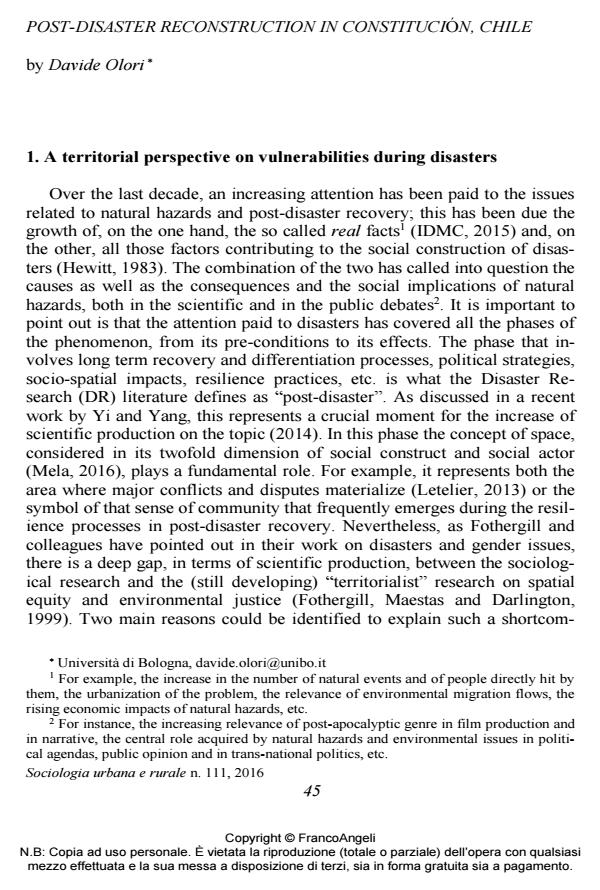Post-disaster reconstruction in Constitución, Chile
Journal title SOCIOLOGIA URBANA E RURALE
Author/s Davide Olori
Publishing Year 2017 Issue 2016/111
Language English Pages 19 P. 45-63 File size 587 KB
DOI 10.3280/SUR2016-111003
DOI is like a bar code for intellectual property: to have more infomation
click here
Below, you can see the article first page
If you want to buy this article in PDF format, you can do it, following the instructions to buy download credits

FrancoAngeli is member of Publishers International Linking Association, Inc (PILA), a not-for-profit association which run the CrossRef service enabling links to and from online scholarly content.
The post-disaster reconstruction of territories hit by an environmental disaster further stresses the existing social polarizations and the latent conflicts within the areas where the event takes place. Through a chilean case study, we hypothesize that the investigation of the ways social actors move across the city allows us to understand how people return to "normality" when forced to re-organize their lives in the post-disaster phase.
Keywords: Reconstruccion, vulnerability, disaster, Constitución, socio-spatial dynamics, social inequality.
- Bazzucchi A. (2010). I costi della città dispersa: prime evidenze. In E. Minardi, R. Salvatore, O.R.eS.Te. Osservare, comprendere e progettare per ricostruire a partre dal terremoto dell’Aquila. Teramo: HomeLess Book.
- Bolin B. (2007). Race, Class, Ethnicity, and Disaster Vulnerability. In E.D. Quarantelli, Handbook of disaster research. New York, NY: Springer.
- Cociña Varas C., Boano C. (2013). Housing and Reconstruction in Chile (2010-2012) Institutional and social transformation in post-disaster contexts. International Journal of Architectural Research, 7(3): 57-59.
- Cutter S. (1995). Race, class, and environmental justice. Progress in Human Geography, 19: 107–118. DOI: 10.1177/03091325950190011
- Dash N., Morrow B., Mainster J., Cunningham L. (2007). Lasting Effects of Hurricane Andrew on a Working-Class Community. Natural Hazards 8:1(13), 13-21. , 8(13), 13-21. DOI: 10.1061/(ASCE)1527-6988(2007)8:1(13
- Del Carmen-Contreras Y., Beltràn-Benitez M. (2015, 5). Reconstruire con capacidad de resiliencia: el casco historico de la ciudad de Constituciòn y el sitio del desastre del terremoto y tsunami del 27 de febrero 2010. Invi, 83(30), 79-115. DOI: 10.4067/S0718-8358201500010000
- Elliott J., Pais J. (2010). When Nature Pushes Back: Environmental Impact and the Spatial Redistribution of Socially Vulnerable Populations. Social Science Quarterly, 91(5): 1187-1202.
- Fothergill A., Maestas E.G., Darlington J.D. (1999). Race, ethnicity, and disasters in the United States: A review of the literature. Disasters, 23(2): 156–173. DOI: 10.1111/1467-7717.0011
- Fox Gotham K. (2016). Re-anchoring capital in disaster- devastated spaces: Financialisation and the Gulf Opportunity (GO) Zone programme. Urban Studies, 53(7): 1362–1383. DOI: 10.1177/004209801454811
- Gotham F., Greenberg M. (2015). Crisis Cities. New York: Oxford University Press.
- Hewitt K. (1983). Interpretation of Calamity from the perspective of human ecology. Boston: Allen and Unwin.
- IDMC. (2015). Global Estimates 2015 People displaced by disasters. Norwegian Refugee Council, Internal Displacement Monitoring Centre. Ginevra: Internal Displacement Monitoring Centre.
- International Labour Office (2010). Informe de Anàlisis Economico y Social. Subregional Office for the Southern Cone of Latino America, Fundacion Instituto de Estudios Laborales. Santiago de Chile: ILO.
- King L., McCarthy D. (2005). Environmental sociology: From analysis to action. New York, NY: Rowman-Littlefield.
- Letelier F. (2013). Guía para el fortalecimiento del Territorio. Talca: CEUT-Surmaule-UCM.
- Letelier F., Boyco P. (2011). Talca posterremoto: una ciudad en disputa. Talca: SUR.
- MINVU. (2010). Chile Unido Reconstruye Mejor. Gobierno de Chile, Ministerio de Vivienda y Urbanismo. Santiago: Gobierno de Chile.
- Moore H. (1958). Tornadoes over texas. Austin, TX: University of Texas Press.
- ONU (2010). Terremoto. Informe situacion n. 19. ONU, Oficina Coordinador Residente Chile. Santiago de Chile: ONU.
- Oszlack O. (1991). Merecer la ciudad: los pobres y el derecho al espacio urbano. Buenos Aires: CEDES-Humanitas.
- Pellow D., Weinberg A., Schnaiberg A. (2005). The environmental justice movement: Equitable allocation of the costs and benefits of environmental management outcomes. In L.M. King, Environmental sociology: From analysis to action. Lanham, MD: Rowman Littlefield.
- Renna H. (2011). Siete y Cuatro. El retorno de los pobladores. Lucha por la vivienda, autogestión habitacional y poder popular en Santiago de Chile. Santiago de Chile: Quimantù.
- Rodríguez A., Sugranyes A. (2005). Los con techo. Un desafio para la vivienda social. Santiago de Chile: SUR.
- Stallings R. (2002). Weberian Political Sociology and Sociological Disaster Studies. Sociological Forum, 17(2): 281-305. DOI: 10.1023/A:101604131404
- Tapia Z.R. (2014). Terremoto 2010, Chile: Evaluación de la aplicación de normativa urbana/rural en políticas públicas. Algunos resultados. In C. Catalina-Arteaga, R. Tapia-Zarricueta, Vulnerabilidades y desastres socionaturales: experiencias recientes en Chile. Santiago: Editorial Universitaria.
- Tiefenbacher J., Hagelman R. (1999). Environmental equity in urban Texas: Race, income, and patterns of acute and chronic toxic air releases in metropolitan counties. Urban Geography, 20: 516–533. DOI: 10.2747/0272-3638.20.6.51
- Tierney K.J. (2007). From to the margins to the mainstream: disaster research at the crossroads. Annual Review of Sociology, 33: 502-525.
- Yang J., Yi H. (2014). Research trends of post disaster reconstruction: The past and the future. Habitat International, 42: 21-29.
Davide Olori, Post-disaster reconstruction in Constitución, Chile in "SOCIOLOGIA URBANA E RURALE" 111/2016, pp 45-63, DOI: 10.3280/SUR2016-111003